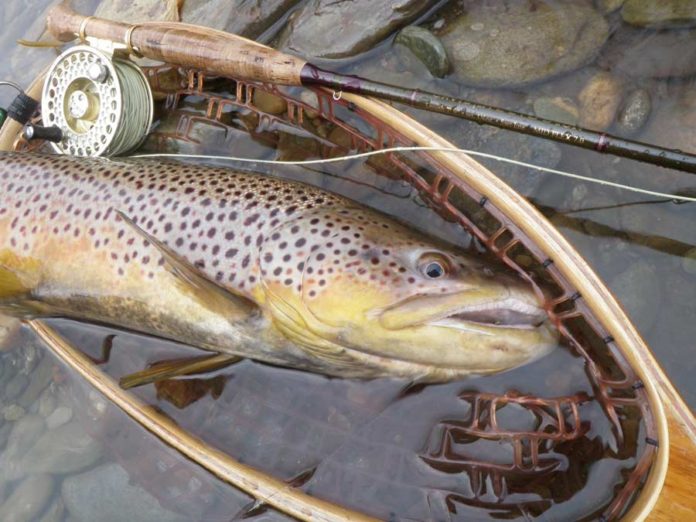Written by Drew Price
The author with a fine autumn brown trout that he stalked and caught on a streamer.
All photos courtesy Drew Price
It’s the season to get into some really big wild brown trout. They are setting up for the spawn right now, and this is some of my favorite fishing of the entire year. If you do things right, you could land the biggest trout of your life, so here are a few things that you can do to improve your odds:
- Use good hooks. It seems pretty simple, but the hook you use really makes a big difference. A good chemically sharpened hook will let you get a much better hook set. Higher quality hooks are much less likely to bend or break on you, too. Good hooks are worth the extra money you pay for them. A 1X- or 2X-strong hook is less likely to bend under strain and it also weighs a bit more to get the fly deeper faster.
- Use fluorocarbon tippet. Water in the fall tends to be shallow and clear , and fluoro makes it less likely that the fish will see your leader. The material also sinks very easily, and since this is primarily a sinking flies game, that helps out. Big browns are sneaky and will try all they can to wrap you around rocks and snags, so the abrasion resistance that fluoro has makes a big difference. It is definitely more expensive, but it is worth it. Mirage has been my tippet of choice for many years.
- Wear polarized glasses. It is amazing how many folks I have guided showed up without a pair of good sunglasses. Yellow or copper lenses will give you much more color contrast than gray or amber lenses. That contrast will help you pick out fish much more easily.

Fall often means low water, which allows you to sight-fish to big trout, a game
that requires stealth and careful wading. - Get sneaky. I wear camouflage. Seriously. It makes a difference. A couple of years ago, I wore a camo jacket and my fishing partner had on a tan vest. I got within 10 feet of a large brown in 18 inches of water, and it didn’t spook. My friend quietly came up next to me, and the fish bolted. Wearing clothing that breaks up your profile and blends you into the background will make a huge difference on small streams where you can sight-fish. Your buddies might laugh at you, but you will get the final laugh when you show them the picture of the beast of a brown you nailed.
- Walk softly. The trout’s lateral line is very sensitive. If you are walking around like a moose crashing through the brush, you will scare fish off. It is much more important to walk softly than it is to not talk loudly. If you walk softly and slowly, you also have a much better chance of seeing fish before they spot you.
- Stay out of the water as much as possible. This is another stealth tip. If you aren’t in the water, you won’t be making any waves that can alert the fish’s lateral line of your presence. I have spooked more big fish than I care to admit by heading right into the water. Look before you leap, and you might be surprised at how close you are to your quarry.

Flies with orange in them seem to excite fall browns, triggering aggressive strikes. - Use a fly with some orange in it. I’m not completely sure why, but big browns hate things that are orange. (Do they think it’s a brook trout?) In the fall, I almost always use flies that incorporate orange in them. There are lots of options, but a couple of favorites are brown and orange Clouser Minnow and McGinnis Extra Stout. I tie olive and black Woolly Buggers with an orange body, too. Another classic pattern you should always carry isn’t exactly orange, but its colors make up orange: the Mickey Finn.
- Use big flies. Now is the time to pull out 5-inch flies. Use size 2 and 4 streamers. Big nymphs are very useful too. Pull out the big stones and Hare’s Ears too. Fall browns are either after a big meal before spawning or are trying to eliminate competition for their progeny, so give them something to get mean with. Leave your #20 Pheasant Tails at home.
- Learn what a redd looks like. Spend some time doing research about what a redd looks like and in what kind of water you will find them. This will accomplish two things: it will help you identify the water where you are likely to find your target fish, and it will tell you where not to walk. Big browns will be found near their spawning areas, so these are places you want to spend time fishing. IHowever, please don’t fish for the spawning trout! Wild fish are very valuable, and the potential damage you do by stressing out spawners is not worth it. Watch them, but leave them be. The subordinate fish that are picking off eggs and nymphs downstream of the spawning pair are a different ballgame altogether though. When you see redds avoid walking through them and stepping on eggs.

Drew’s pal, Kevin Favreau, with a big fall brown. Note the camouflage gear. - Check your gear regularly. Make sure everything is in order with your set up. Put on a new leader, especially if you have been fishing the same leader for a while. Test every knot, and test it twice. Make sure your drag works well and that your knots slide through the guides well. These are big fish, and now is the time to pull out your A game. You need to do all you can to eliminate any errors on your part.
Drew Price lives in Northern Vermont and is the owner and head guide for Master Class Angling. He fishes Lake Champlain and surrounding waters targeting carp, pike, bowfin, gar, bass and other species (even the occasional trout).
Credit: Source link






























